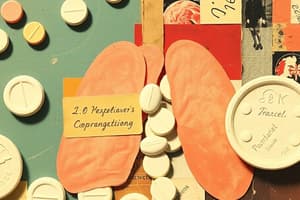Podcast
Questions and Answers
Which part of the respiratory system is innervated by the autonomic nervous system?
Which part of the respiratory system is innervated by the autonomic nervous system?
- Paranasal sinuses
- Nose turbinates (correct)
- Tonsils
- Adenoids
What is the major action of sympathomimetic decongestants?
What is the major action of sympathomimetic decongestants?
- Vasodilation
- Innervation
- Vasoconstriction (correct)
- Mucus secretion
Why should decongestant products be used cautiously in certain conditions?
Why should decongestant products be used cautiously in certain conditions?
- They may worsen existing hypertension (correct)
- They have no potential side effects
- They can lead to vasodilation
- They can cause excessive mucus secretion
What is the function of corticosteroid decongestants?
What is the function of corticosteroid decongestants?
What is the role of cromolyn in the treatment of respiratory conditions?
What is the role of cromolyn in the treatment of respiratory conditions?
What is the major action of antihistaminic decongestants?
What is the major action of antihistaminic decongestants?
Why should decongestant products be used cautiously in certain conditions?
Why should decongestant products be used cautiously in certain conditions?
What is the role of cromolyn in the treatment of respiratory conditions?
What is the role of cromolyn in the treatment of respiratory conditions?
What is the function of corticosteroid decongestants?
What is the function of corticosteroid decongestants?
Which part of the respiratory system is innervated by the autonomic nervous system for vasodilation and mucus secretions?
Which part of the respiratory system is innervated by the autonomic nervous system for vasodilation and mucus secretions?
Flashcards are hidden until you start studying
Study Notes
DRUGS EFFECTING THE RESPIRATORY SYSTEM – Part 1: Key Points
- Learning outcomes include reviewing the function of the respiratory system, listing common upper respiratory diseases, and discussing causes of allergic rhinitis, nasal congestion, and rhinitis medicamentosa.
- The major actions of sympathomimetic, antihistaminic, and corticosteroid decongestants, as well as cromolyn, are explained.
- Decongestant products should be used cautiously in certain conditions due to potential adverse effects.
- Premedication assessments and nursing assessments are discussed as necessary during therapy to monitor therapeutic response and adverse effects of decongestant drug therapy.
- The upper respiratory tract (URT) consists of the nose, turbinates (with blood vessels), goblet cells, and ciliated epithelium, and is innervated by the autonomic nervous system (ANS).
- Cholinergic stimulation causes vasodilation and mucus secretions, while sympathetic stimulation leads to vasoconstriction in the URT.
- The URT also includes paranasal sinuses, tonsils, adenoids, and the reflex of sneezing.
Studying That Suits You
Use AI to generate personalized quizzes and flashcards to suit your learning preferences.




